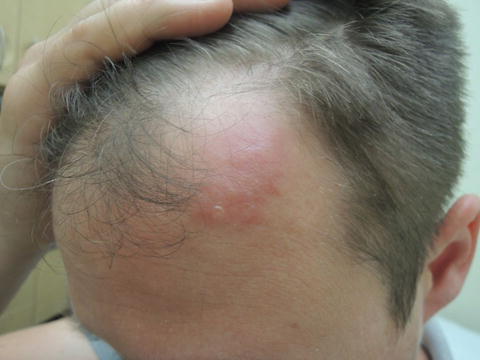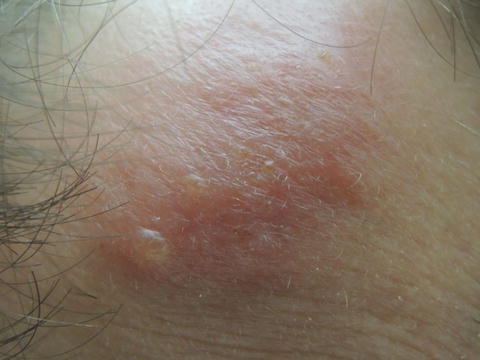, Corinna Eleni Psomadakis2 and Bobby Buka3
(1)
Department of Family Medicine, Mount Sinai School of Medicine Attending Mount Sinai Doctors/Beth Israel Medical Group-Williamsburg, Brooklyn, NY, USA
(2)
School of Medicine Imperial College London, London, UK
(3)
Department of Dermatology, Mount Sinai School of Medicine, New York, NY, USA
Keywords
Herpes ZosterShinglesVaricella zoster virusTrigeminal nerveVesiclesVesicular rashDermatomeValacyclovirAcyclovirPostherpetic neuralgia
Fig. 42.1
This eruption corresponds to the V1 branch of the trigeminal nerve

Fig. 42.2
The classic clustered vesicles on an erythematous base
Primary Care Visit Report
A 29-year-old male with no past medical history presented with bumps on his forehead, behind his left ear, and near his left eye. One week prior, the patient was accidentally hit on his left forehead by a car door while getting in. The next day, he woke up with a bump on his left frontal forehead area where he had been hit. The following day, he noticed a bump behind his left ear. Two days after that, his left medial eye area started to become red and then developed bumps. While his forehead was itchy, none of the other bumps or associated areas were painful. He was afebrile and felt well. He reported having chickenpox as a child. He had tried moisturizer and ice on the lesions; however, neither helped.
Vitals were normal. On exam, on his left superolateral frontal scalp, there was a 3.2 cm × 2 cm area of macular erythema with one fluid-filled vesicle inferiorly. This was non-tender to palpation. Lateral to the left superior aspect of his nose and medial to his left eye, there was a 1 cm × 0.5 cm erythematous macule containing 2 small (1 mm) papules centrally. The left infraorbital area featured edema and erythema. Tender, enlarged lymph nodes were noted at the left occipital and left posterior auricular areas.
This was treated as trigeminal (ophthalmic division) shingles. Given the history of blunt trauma immediately preceding the development of the rash, a bacterial culture was taken to rule out infection. Viral and bacterial cultures were taken from fluid from the forehead lesion, and a CBC, varicella zoster IgM and varicella zoster IgG antibody tests were sent. The patient was started on valacyclovir 1000 mg three times daily for 7 days, and an over-the-counter hydrocortisone cream for the eyelid edema. The viral culture eventually grew out varicella zoster. The patient’s blood tested positive for zoster IgG antibody, but negative for zoster IgM antibody. The bacterial culture grew out normal skin flora only, and the CBC was normal. The patient did well on valacyclovir and hydrocortisone cream. The patient was referred to ophthalmology because of possible eye involvement, but due to cost concerns, lack of vision involvement, and rash improvement with valacyclovir he opted not to go.
Discussion from Dermatology Clinic
Differential Dx
Herpes zoster (shingles)
Contact dermatitis
Insect bitesHerpes, simplex
Favored Dx
Although it is unusual for shingles to present without pain, the erythematous papular and vesicular lesions appear in a unilateral distribution and have a presentation typical of shingles.
Overview
Herpes zoster , or shingles, is caused by the same virus that causes chickenpox. It is a herpesvirus known as varicella zoster virus (VZV) , chickenpox virus , or human herpesvirus type 3 (HHV-3) . Initial infection causes chickenpox, a once ubiquitous childhood infection in the United States, whose incidence has decreased by as much as 90 % since the introduction of varicella vaccines in 1995 [1]. After the initial acute chickenpox illness, the latent virus persists in the sensory dorsal root ganglia and autonomic ganglia. Once reactivated, VZV causes herpes zoster , an erythematous, vesicular unilateral rash that is accompanied by dermatomal pain.
The lifetime risk of herpes zoster is up to 30 % [2]. The decreased incidence of varicella in children has not affected the prevalence of herpes zoster, perhaps because there is reduced repeat exposure to the virus in individuals who already had chickenpox and therefore reduced immune boosting. Herpes zoster can occur at any age, but most commonly occurs in ages 50–59 and generally affects older adults [1–3]. Age is a strong risk factor due to inherently reduced immunity in older individuals, as well as being female and white [1–3]. Although commonly thought to affect immunocompromised populations, and certainly immunocompromised status is a risk factor, one large study found only 8 % of patients with herpes zoster were immunocompromised [3]. The immunocompromised populations most affected are people with HIV, organ transplant recipients, and people on immunosuppressants for autoimmune disorders. Reactivation of VZV can also be triggered by emotional stress and physical trauma to the affected dermatome . Physical trauma can increase risk of herpes zoster by up to eight times [4].

Full access? Get Clinical Tree








